1.
La xarxa de metro de Seul, amb més de 4 milions de passatgers diaris té 436 estacions repartides en un total de 14 línies.
La xarxa de metro de Seul, amb més de 4 milions de passatgers diaris té 436 estacions repartides en un total de 14 línies.
Seoul Metro network, with more than 4 million passengers everyday, has 436 stations in a total of 14 lines.
2.
A les estacions i passadissos transbords hi ha no només quioscos i botigues, hi podem trobar centres comercials gegants, restaurants, llibreries i tota mena de comerços.
A les estacions i passadissos transbords hi ha no només quioscos i botigues, hi podem trobar centres comercials gegants, restaurants, llibreries i tota mena de comerços.
Along the stations halls, and transfers you can find not only kiosks and convenience stores. The are whole department stores and malls, restaurants, bookstores and ll kind of shops underground.
3.
Hi ha cobertura de xarxa de mòbils i de DMB (televisió i ràdio al mòbil) a totes les línies i túnels. Això fa que bona part dels passatges estiguin enganxats a pantalles de telèfons mòbils i PMP (reproductors multimèdia portàtils) veient la tele, sèries o pelis. O jugant amb consoles portàtils com PSP i NintendoDS.
Hi ha cobertura de xarxa de mòbils i de DMB (televisió i ràdio al mòbil) a totes les línies i túnels. Això fa que bona part dels passatges estiguin enganxats a pantalles de telèfons mòbils i PMP (reproductors multimèdia portàtils) veient la tele, sèries o pelis. O jugant amb consoles portàtils com PSP i NintendoDS.
There is full cellhpone network and DMB (digital mobile television and radio) coverage in all stations and lines. That means that most of passengers are stuck on screens of cellphones and PMP watching tv, dramas, or movies. Or playing with portable videoconsoles such as PSP or NintendoDS.
4.
Algunes estacions (i en un futur s'espera que totes) tenen un separador amb portes de vidre entre les vies i l'andana. És una qüestió de seguretat per prevenir caigudes accidents i suïcidis. El sistema automàtic permetrà que en un futur els metros no necessitin conductor, fet que recentment ha provocat queixes i vagues per part dels treballadors del servei de metro.
Some stations (and soon in the future, in all) have some kind of glass separator with doors between the platform and the rails. It's a securuty system to prevent fallings, accidents and suicides. This automatic system will allow to do without drivers. So, some workers complained about this with some strikes.
5.
En algunes línies i combois hi ha pantalles amb publicitat i curioses instruccions i advertències de comportament al metro. Una de les més impactants que recordo haver vist, és de "com han de vestir les noies si no volen ser observades" i mostra noies vestint minifaldilles sent mirades per homes, i noies amb pantalons sent ignorades.
In some lines and cars there are screens with funny and interesting warnings about behaviour in the subway. One of the most shocking warnings I remember is that one about "how women should wear if they don't want to feel harassed" and it shows some women wearing mini skirt and being watched by men, and women wearing pants or jeans and being ignored by men.
6.
A tots els vagons hi ha uns seients reservats per gent gran, discapacitats, embrarassades i gent amb dificultats. Fins aquí, normal, no? El més curiós és que els seients poden quedar buits mentre el vagó està a rebentar de gent jove (asseguda i dreta, clar). Es respecten aquests seients sempre i encara que al vagó no hi hagi gent que els necessiti.
In all cars there are some reserved seats for old people, pregnant women or disabled people. Quite normal, uh? But the interesting thing is that everybody respects this seats. The car can be full of young people (standing and seated) but thet seats can be empty.
7.
La majoria d'estacions tenen un gran nombre de sortides. N'he arribat a comprar fins a 12. Estàn numerades, i és una manera fàcil de localitzar direccions i establiments. Quan la gent queda, sovint queda a la sortida X de l'estació que sigui.
La majoria d'estacions tenen un gran nombre de sortides. N'he arribat a comprar fins a 12. Estàn numerades, i és una manera fàcil de localitzar direccions i establiments. Quan la gent queda, sovint queda a la sortida X de l'estació que sigui.
Most of stations have a huge number of exits. I remember counting at least 12. They are numbered, and it's an easy way to find locations. When people have to meet somewhere, they use this numbers to make easy to meet.
8.
Algunes línies del metro, tenen trams on el corrent és en sèrie. Amb la qual cosa, durant el trajecte hi ha apagades de llums per estalviar energia. No sé ben bé com va la cosa, si us atreviu feu una ullada aquí.
Some subway lines, have some parts with DV electricity. With this, there are some blackouts inside the cars to save energy. Well, I don't know exactly how it works, but you can have a look here .
9.
A l'hivern tots els seients estan calents. Hi ha un sistema de calefacció que manté els seients calents. Dóna gust seure-hi!
A l'hivern tots els seients estan calents. Hi ha un sistema de calefacció que manté els seients calents. Dóna gust seure-hi!
In winter, all seats are warm. There's some heater system that keeps the seats warm. It's so nice to seat there!
10.
Tot i que Seül és una ciutat que no dorm, i hi ha molts establiments oberts tota la nit i durant 24 hores, el metro tanca inclús les nits dels caps de setmana. Però a diferència del d'altres ciutats, els horaris de tancament varien segons l'estació. No és l'últim metro el que determina el tancament. Pot passar que estiguis viatjant i el servei s'acabi a mig trajecte, havent de baixar algunes estacions abans de la desitjada.
Even though Seoul is a city that doesn't sleep, there are many 24 hours shops and places to go, the subway closes at weekend nights. But, not as many other cities, the closing times are different depending on the station. It's not the last train the one which makes closing the station. It can happen that we are going somewhere and subway service finishes in the middle of the journey, so you have to get off some stations before the one you wanted.
Alerta al nom de l'estació!
Check out the station name!

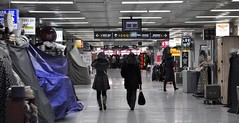

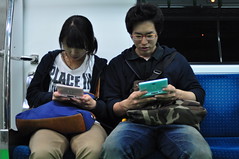
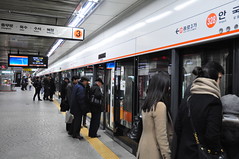
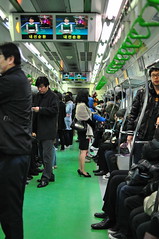


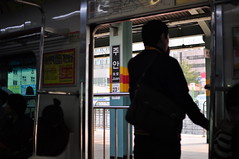

Mare meva, quin follón de mapa...
ResponEliminaSule
El metro de Seül és per a perdre's-hi. Et pots trobar moltes coses. Una de les que més em va impressionar va ser la llargària dels vagons del mateix metro, increible, sortia el metro i no s'acabava mai. Ara no recordo si era el de la llínia 1 o la 3 però dóna igual.
ResponElimina:)
carai, quina crònica! amb aquesta explicació ja m'atreviria a viatjar-hi. però no has mencionat res de les taquilles, ni si la gent es cola, com a bcn. suposo que si són tan respectuosos amb el tema dels seients... tampoc deuen fer les gamberrades d'aquí: fumar, grafitis, etc... apa, bon viatge!! tere
ResponElimina@Sule
ResponEliminasí, el mapa és gran, però mai utilitzem les linies que van fora del centre.
la majoria de mòbils coreans tenen un mapa interactiu al telèfon mòbil, on et pots crear trajectes i et diu els transbords, parades i estona que es triga! mola, eh?
@paelladekimchi.com
i tant! tants passadissos! amb alguns amics diem que Seül té una altra Seül sota terra! sembla que allà on foradis s'hi ha de trobar metro, botigues, centres comercials...
sobre la llarga...costa aprendre's on baixar a les estacions! seria molt útil que indiquin en quin vagó cal estar per anar a la sortida X o al transbord Y!
@tere
la gent en general no es cola (i és prou fàcil). res de fumar al metro! grafitis? què és això? XD el que sí hi ha a vegades és vells borratxos que ocupen més d'un seient, o que els costa aguantar l'equilibri...
Korea.net is the official website of the Rep. of Korea. For our “Blogging on Korea” section on our webpage, we pick nice and appropriate blog posts and introduce them to our visitors.
ResponEliminaAny blog posts about Korea (Korean food, life, people, festival etc), we read thoroughly and feature it on our web for a couple of days.
We’d like to outlink your blog post “10 facts about Seoul subway” on our web, so we can share it with our visitors. Thank you for your source, and please visit our website and other official social networking channels.(see the links below)
twitter: http://twitter.com/koreanet
facebook: http://www.facebook.com/pages/Seoul-South-Korea/Korea-Clickers/181274814520
@korean.net, i'd be glad if you pick my article and link it to my blog.
ResponEliminathank you.
and i'm already following you on twitter! :)